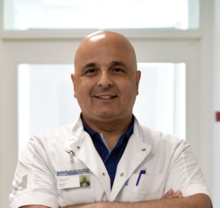Messoud Ashina is a Danish-Azerbaijani neuroscientist
Messoud Ashina (born December 29, 1965) is a Danish-Azerbaijani neurologist and neuroscientist.[1][2] He is currently Professor of Neurology at the University of Copenhagen and Senior Consultant of Neurology at Copenhagen University Hospital - Rigshospitalet. He leads the Human Migraine Research Unit at the Danish Headache Center, Copenhagen University Hospital - Rigshospitalet.[1] Ashina is also Director of the Danish Knowledge Center on Headache Disorders and Past President of the International Headache Society.[3][4] As of 2023, Ashina is ranked as the world's leading expert on headache disorders by Expertscape.[5]
Education
Ashina earned his medical degree at the age 22 from Azerbaijan Medical University in 1988.[1][6] He later received his PhD and D.M.Sc. degrees at University of Copenhagen and completed his residency in neurology at Copenhagen University Hospitalet - Rigshospitalet.[1]
Personal life
Messoud Ashina was born on December 29, 1965, in Baku, Azerbaijan.[6] His father, Rustam Ashina was an architect, while his mother, Nelli Hajiyeva, is a retired biologist.[1]
He lives in Copenhagen and is married to Camilla Ashina who is a dentist.[6] They have two children.
Research
Ashina is an acclaimed neuroscientist and considered one of the most prolific contributors to headache sciences.[5] His academic works focus on migraine,[7] which is a ubiquitous neurological disorder that affects more than one billion people worldwide.[8] Ashina and his research lab have been key figures in the development and refinement of human provocation models that can be used to map signaling pathways underlying migraine pathogenesis and to identify novel drug targets.[7][9][10] In these provocation models, endogenous signaling molecules or other hypothesized 'trigger' agents are used to induce migraine attacks in people with migraine, whereas healthy volunteers most often develop no more than a mild headache.[7]
In his early work, Ashina and colleagues discovered that intravenous infusion of pituitary adenylate cyclase-activating polypeptide-38 (PACAP-38) induced migraine attacks in about 60% of people with migraine without aura.[11] Ashina then posited that accumulation of intracellular cyclic adenosine monophosphate (cAMP) must play an important role in migraine pathogenesis because the intracellular effects of PACAP-38 receptor-binding are mediated by cAMP-dependent signaling pathways.[11] This was confirmed by Ashina's lab when oral administration of cilostazol - a blocker of cAMP degradation - induced migraine attacks in about 80% of people with migraine without aura.[12] Ashina later hypothesized that downstream effects of cAMP-mediated migraine attacks were likely to involve opening of potassium channels.[7] This hypothesis has been supported by experimental data from provocation studies, in which Ashina and colleagues demonstrated that openers of adenosine-triphosphate (ATP)-sensitive potassium channels and large conductance calcium-activated potassium channels induced migraine attacks in about 95 to 100% of people with migraine without aura.[9][13][14] Furthermore, Ashina and colleagues have also found that intravenous infusion of an ATP-sensitive potassium channel opener appears to be a potent inducer of migraine attacks with aura in people with migraine with aura.[15]
Publications
Ashina has authored over 400 papers, abstracts and book chapters, including more than 300 registered publications in PubMed (1997-2023).[16] He is the editor of the book 'Pathophysiology of Headaches'. His overall citation index is 20,142 (13,278 since 2018), and he has an H-index of 76 (58 since 2018).[17]
